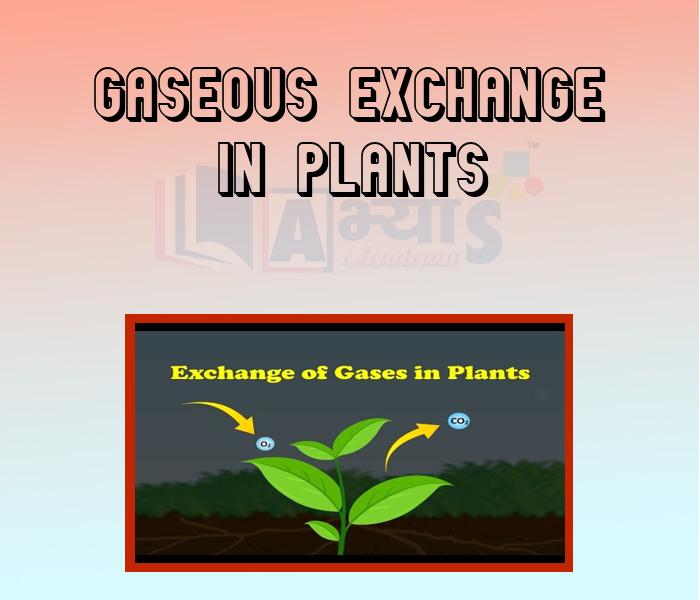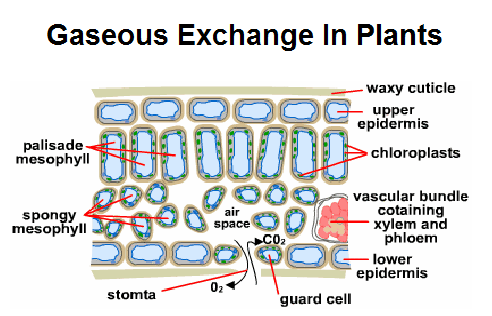Gaseous Exchange In Plants


Gaseous Exchange In Plants
For the process of respiration,plant takes and releases
. Plants have stomata and lenticels for gaseous exchange instead of specialised organs that are present in animals for exchange of gases.
Following are the reasons which show, how plants can get along without respiratory organs :-
(i) Every part of the plant has the ability to take care of own needs of gas exchange and also very little transport of gases occur from one part of the plant to another.
(ii) It is only during the process of photosynthesis that large volumes of gases are exchanged and each leaf of the plant has ability to take care of its own needs
during these periods. Thus, when cells photosynthesize, availability of is not a problem in these cells due to a continuous release of
that takes place within the cell.
(iii) Gases may easily diffuse in large, bulky plants as distance for diffusion is not so great because living cells in a plant are located quite close to the surface of the plant.
In case of stems, which are thick and woody in nature.. The organisation of living cells is in the form of thin layers, which are found inside and beneath the bark. Like leaves which have stomata for gaseous exchange, these stems also have openings called lenticels. Internal cells are dead and provide only mechanical support to the plant.
This depicts that most cells of plant have atleast a part of their surface in contact with the air. The loose packing of parenchyma cells in leaves, stems and roots and provides an interconnected network of air spaces which help in facilitating this process.

Gaseous Exchange In Plants
For the process of respiration,plant takes and releases
. Plants have stomata and lenticels for gaseous exchange instead of specialised organs that are present in animals for exchange of gases.
Following are the reasons which show, how plants can get along without respiratory organs :-
(i) Every part of the plant has the ability to take care of own needs of gas exchange and also very little transport of gases occur from one part of the plant to another.
(ii) It is only during the process of photosynthesis that large volumes of gases are exchanged and each leaf of the plant has ability to take care of its own needs
during these periods. Thus, when cells photosynthesize, availability of is not a problem in these cells due to a continuous release of
that takes place within the cell.
(iii) Gases may easily diffuse in large, bulky plants as distance for diffusion is not so great because living cells in a plant are located quite close to the surface of the plant.
In case of stems, which are thick and woody in nature.. The organisation of living cells is in the form of thin layers, which are found inside and beneath the bark. Like leaves which have stomata for gaseous exchange, these stems also have openings called lenticels. Internal cells are dead and provide only mechanical support to the plant.
This depicts that most cells of plant have atleast a part of their surface in contact with the air. The loose packing of parenchyma cells in leaves, stems and roots and provides an interconnected network of air spaces which help in facilitating this process.

Students / Parents Reviews [10]
Abhyas is a complete education Institute. Here extreme care is taken by teacher with the help of regular exam. Extra classes also conducted by the institute, if the student is weak.

Om Umang
10thMy experience with Abhyas academy is very good. I did not think that my every subject coming here will be so strong. The main thing is that the online tests had made me learn here more things.

Hiya Gupta
8thAbout Abhyas metholodology the teachers are very nice and hardworking toward students.The Centre Head Mrs Anu Sethi is also a brilliant teacher.Abhyas has taught me how to overcome problems and has always taken my doubts and suppoeted me.

Shreya Shrivastava
8thA marvelous experience with Abhyas. I am glad to share that my ward has achieved more than enough at the Ambala ABHYAS centre. Years have passed on and more and more he has gained. May the centre flourish and develop day by day by the grace of God.

Archit Segal
7thBeing a parent, I saw my daughter improvement in her studies by seeing a good result in all day to day compititive exam TMO, NSO, IEO etc and as well as studies. I have got a fruitful result from my daughter.

Prisha Gupta
8thIt was a good experience with Abhyas Academy. I even faced problems in starting but slowly and steadily overcomed. Especially reasoning classes helped me a lot.

Cheshta
10thIt was good as the experience because as we had come here we had been improved in a such envirnment created here.Extra is taught which is beneficial for future.

Eshan Arora
8thMy experience with Abhyas is very good. I have learnt many things here like vedic maths and reasoning also. Teachers here first take our doubts and then there are assignments to verify our weak points.

Shivam Rana
7thAbhyas Methodology is very good. It is based on according to student and each child manages accordingly to its properly. Methodology has improved the abilities of students to shine them in future.

Manish Kumar
10thMy experience was very good with Abhyas academy. I am studying here from 6th class and I am satisfied by its results in my life. I improved a lot here ahead of school syllabus.
